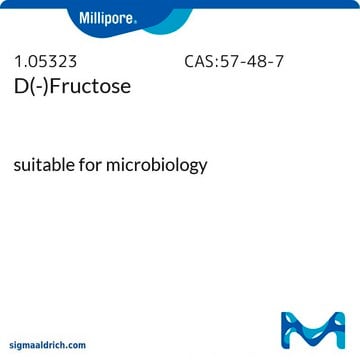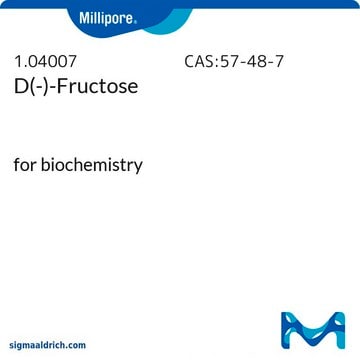F2543
D-(−)-Fructose
≥99% (HPLC), BioXtra
Synonym(s):
D-Levulose, Fruit sugar
About This Item
Recommended Products
biological source
corn
Quality Level
product line
BioXtra
Assay
≥99% (HPLC)
form
powder
technique(s)
HPLC: suitable
impurities
<0.0005% Phosphorus (P)
<0.05% glucose (enzymatic)
<0.1% Insoluble matter
ign. residue
<0.1%
color
colorless
useful pH range
5.0-7.0 (25 °C, 18 g/L)
mp
119-122 °C (dec.) (lit.)
solubility
H2O: 1 M, clear, colorless
anion traces
chloride (Cl-): <0.05%
sulfate (SO42-): <0.05%
cation traces
Al: <0.0005%
Ca: <0.0005%
Cu: <0.0005%
Fe: <0.0005%
K: <0.005%
Mg: <0.0005%
NH4+: <0.05%
Na: <0.005%
Pb: <0.001%
Zn: <0.0005%
SMILES string
OC[C@@H](O)[C@@H](O)[C@H](O)C(=O)CO
InChI
1S/C6H12O6/c7-1-3(9)5(11)6(12)4(10)2-8/h3,5-9,11-12H,1-2H2/t3-,5-,6-/m1/s1
InChI key
BJHIKXHVCXFQLS-UYFOZJQFSA-N
Looking for similar products? Visit Product Comparison Guide
General description
Application
<li><strong>Intracellular metabolomics and microRNAomics unveil new insight into the regulatory network for potential biocontrol mechanism of stress-tolerant Tricho-fusants interacting with phytopathogen Sclerotium rolfsii Sacc.</strong>: Explores the intracellular metabolomic and microRNAomic responses in Tricho-fusants, with D-(-)-Fructose identified as a key metabolite in stress tolerance and biocontrol mechanisms (Hirpara Gajera, 2023).</li>
<li><strong>Enzyme-based amperometric biosensors: 60 years later … Quo Vadis </strong>: Reviews advancements in enzyme-based biosensors over the past six decades, including the use of D-(-)-Fructose in the development of new biosensing technologies for clinical and environmental applications (Bollella, 2022).</li>
</ul>
Other Notes
Storage Class Code
11 - Combustible Solids
WGK
WGK 1
Flash Point(F)
Not applicable
Flash Point(C)
Not applicable
Personal Protective Equipment
Choose from one of the most recent versions:
Certificates of Analysis (COA)
Don't see the Right Version?
If you require a particular version, you can look up a specific certificate by the Lot or Batch number.
Already Own This Product?
Find documentation for the products that you have recently purchased in the Document Library.
Customers Also Viewed
Chromatograms
application for HPLCOur team of scientists has experience in all areas of research including Life Science, Material Science, Chemical Synthesis, Chromatography, Analytical and many others.
Contact Technical Service







